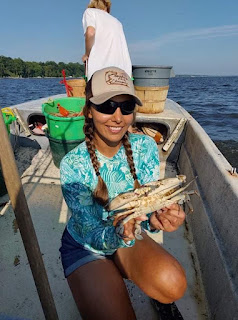Researchers with the University of Maryland Center for Environmental Science say they have unlocked the complete genetic code for the blue crab, a keystone of the Chesapeake Bay’s ecosystem and regional seafood staple.
The facility’s feat comes 18 years after the human genome was first sequenced. Like that landmark effort, the untangling of the blue crab’s genetic blueprint could lead to many practical applications, according to the Maryland research team. Among them: potentially opening the door to farming crabs as an alternative to harvesting wild populations.
“Understanding what makes them successful is located in the chromosomes,” said Sook Chung, the researcher who led the project at UMCES’ Institute of Marine and Environmental Technology on Baltimore’s Inner Harbor. “Knowing the full genome, we are several steps closer to identifying the genes responsible for growth, reproduction and susceptibility to disease.”
Researchers will have no shortage of places to look in cracking those mysteries. The study found between 40 and 50 chromosomes in the crab genome, nearly twice as many as its human counterpart. Within those chromosomes, researchers uncovered about 24,000 genes, slightly more than what humans have .
Mike and Trish Davis, a couple enmeshed with Maryland environmental advocacy efforts, chose to champion the study after soliciting project ideas from leadership at the Marine and Environmental Technology center. “I thought it was a sexy project but also a challenge to fund because a lot of people don’t understand the genome,” said Mike Davis, a former software executive.
They brought in several other deep-pocketed donors, persuading them during private tours of the facility.
Now that the genome has been sequenced, researchers can open new avenues of inquiry into the blue crab, the researchers said.
It could be used, for example, for tracking the geographic origins of crab meat purchased at markets and restaurants. That could help advocates for Bay-caught crabs in their fight against the scourge of improperly labeled imported crab meat.
The genome could also make it possible to sustain blue crab hatchery or aquaculture operations in the Bay region – and thereby reduce pressure on the wild population, Bachvaroff suggested. One of the biggest obstacles in aquaculture is that crabs molt their hard shells as they grow, and their fellow crabs will eat them while they’re defenseless. If their genetic code could be harnessed to cause them to molt at the same time, enough might survive into adulthood to make such ventures viable.
It's a great accomplishment, but I'm not holding my breath while they develop useful inventions from it.
The Wombat has Rule 5 Sunday: Denise Richards ready and waiting at The Other McCain.



No comments:
Post a Comment